Australia trip 2007
Australia 1 Dec 07 – 17 Dec 07
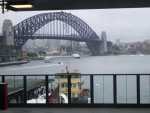
My first real view of Sydney after leaving the airport. From the train at Circular Quay. However, I was in Sydney just 3 days before embarking on my trip to Victoria.

I'm glad you asked. The path of my expedition:
- Sydney
- Tarcutta
- Holbrook
- Bonnie Doon/Lake Eildon
- Seville
- Melbourne
- Geelong
- Ballarat
- Creswick
- Bendigo
- Echuca
- Gundagai
- Canberra
- Fitzroy Falls (friend's farm)

The Hume Highway is the road connecting Australia's two largest cities. I was very surprised that perhaps 10% of its 800 km/500 miles is still not a divided road. Note the oncoming semi. I will admit though that there is little traffic out here and there is major road construction nearby.
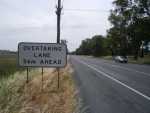
Much of that 10% is actually a 3-lane road so each side takes turns in who gets the overtaking lane. Still 5 kms/3 miles can be a long time to wait if you are behind a slow vehicle.
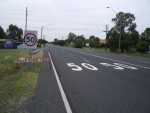
Not only that but the highway still passes through a few towns where you have to slow down to 50 km/h (30 mph), or 40 km/h in a school zone. As compensation, there are train rides today. So the sign says.

Highway rest areas in Australia are simple by American standards but this really does take minimalism to extreme. Yes, you can pull off the road.

Water is available at the rest area. Just don't drink it!
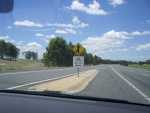
Unlike the interstate highways in America where you are generally not allowed to ride bicycles, it is quite legal on the Hume. The government even posts friendly suggestions on where to cross with the least chance of being run over.

I stopped at Tarcutta to see the memorial to truck drivers killed on Australian roads. At the time I thought it an unusual thing to create a memorial about but in retrospect it is no different to those honoring police or fire fighters killed in the line of duty.
One thing I quickly learned about Tarcutta and everywhere in the country is that it has been a particularly good year for flies. As soon as I got out of the car, it seemed a dozen were buzzing around my head making it difficult to hold the camera steady and eager to get back in the car as soon as possible.

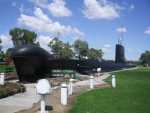
Now this is weird - a submarine a very long way from the ocean. The people of Germantown thought the name inappropriate after WW1 broke out so they renamed it to honor a local hero who commanded a submarine in the Dardanelles (Turkey). A more recent submarine was cut into pieces and reassembled to get passers-by to stop in the town now called Holbrook. It worked for me.

This is Lake Eildon at Bonnie Doon. Or where Lake Eildon would be if there was water.
There is water elsewhere in what is a huge lake when full. The site www.lakeeildon.com says that "As at December 20, 2007, Lake Eildon was sitting at 23.8% of full capacity" which according to lakeeildon.turbo.net.au/board/viewtopic.php?t=175, means it is 28.25m/82 ft down from the maximum level! At any rate, I suspect the Lakeside Resort on the other side of these bridges has been doing little business in the last few years.
If you've seen The Castle, you might remember that this is where the Kerrigan family came for their holidays.
This pedestrian/cycle bridge once carried the railway line; the road bridge runs in parallel to the right.
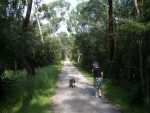
A track, that was once a railway line, near my aunt's house near Seville, north-east of Melbourne.

The cows look bored. I think we were the most exciting thing they had seen all day

What you can't see in this photo is how many flies were about. (A lot.)

A mile marker, presumably for the benefit of the rail passengers, when there were rail passengers—and when we measured distances in miles. Australia was largely on the metric system by 1974 and virtually fully converted by 1977.
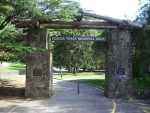
My aunt and uncle took me to the "1000 steps" Kokoda Track Memorial Walk" which seeks to honor those who died fighting the Japanese in New Guinea. See en.wikipedia.org/wiki/Kokoda_Track_campaign for more information.

Just like the real thing minus the heat, humidity, insects, leeches, thorns, neat path, heavy pack on your back and of course, people shooting at you. Still, it gave you a sense of the ruggedness of the terrain.
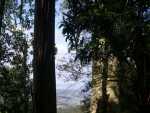
We are a long way up.

This remarkable art gallery is to my mind, in the middle of nowhere, although I'm sure the locals would disagree with that assessment. That's my aunt and uncle leaning against the wall.

I regret I've forgotten the name of the gallery. I thought it was “Tarawa” but I can't find it anywhere on the internet.

The view to the neighboring vineyard. My uncle stands in the opening.

Some ceramic work done by a cousin of mine.


Spencer St railway station in downtown Melbourne. I got off the #96 tram (light-rail) just outside here.

Next tp Spencer Street Station. Note the tram (US: streetcar) entering the intersection.

The guidebook suggested that I should start my tour by seeing Chloe. I'm headed in the right direction. I can't believe I didn't get the top of the sign in the photo.

This painting was supposed to hang in the Art Gallery of Victoria but was deemed too risqué at the time.
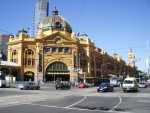
This landmark building serves as the central railway station for Melbourne with 110,000 commuters and 1,500 trains passing through each weekday. More on Wikipedia.


A fine-looking building.

When I originally put the photos on Flickr I said, "I'll look it up later". I lied.
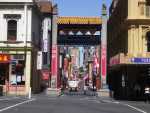
The Chinese originally came during the 1850s gold rush but blatantly racist policies were introduced starting in 1855 to discourage and then finally prevent them coming.
A tax on Chinese arriving by ship in Victoria prompted two-thirds of the 30,000 headed to the gold fields to disembark in Robe, South Australia instead. This meant that they had to WALK 440km/275 miles, a journey that took a full month, rather than 120km/75 miles from Melbourne.
The last vestiges of the "White Australia Policy" were removed only after the Whitlam government took office in 1972.

The State Library
I wanted to visit the Library partly because it is a grand, historic building but also I was hoping for free internet access so I could email Lan and they did indeed have terminals available for public access.
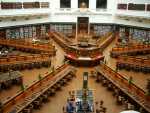
Magnificent but old-fashioned—and poorly attended.

This looks too modern to be part of the original building.

Since trams have right-of-way over cars, Melbourne drivers exercise a bizarre manoeuver when turning right (across oncoming traffic - remember that Australians drive on the left/correct side of the road). First they get in to the far LEFT lane and then they sit there until no one is coming or the light changes to yellow then they shot across the intersection. At some places downtown, there is a marked lane to do this. I'm glad I was never anywhere where I had to attempt it

I was hoping for a plaque explaining what the poles are for and why they were placed there but I looked in vain. Actually it was quite hot and I wanted to be in the shade and avoid getting burned.

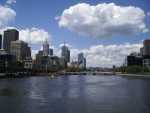

Arguably the most flamboyant street awning in Australia.

…unless it is this one

What a great name for a linen shop! Acland St in St Kilda.
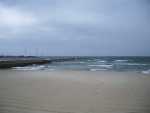
The beach at St Kilda was it's original attraction making, what was then a separate town, a holiday destination for Melbourne residents.

It was a tad windy the day I visited. It was dangerous to look into the wind for fear of getting sand blown into your eyes.

Since there were tourists in St Kilda, developers figured they'd like to do something other than sit on the beach so they built an amusement park. Finding this was something of a surprise as I'd walked in this direction only to find the beach. I know that there is a Luna Park in Sydney but was blissfully unaware of a parallel version in Melbourne. The Sydney version has a happier face.

I stopped here for breakfast before leaving Melbourne.

The cake was indeed good, though perhaps not as phenomenal as Daven Wu would have us believe. He can't be that famous. He does not have a Wikipedia entry.

Geelong was a run-down industrial city near Melbourne. Now the industry is gone. However, they've made an effort to brighten up the waterfront by installing lots of "bollards" carved into whimsical figures as part of a large project to beautify the city and attract tourists. Here's a rowing crew.


OK, that's enough of bollards. There were plenty more but I won't bore you.

There were a bunch of these little characters affixed to the rocks nearby.


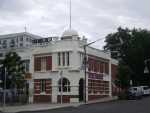

This was the reason I diverted to Geelong. It is in the original wool storage facility.
Wool was Australia's first major export as it was an agricultural product for which local conditions were well-suited and which would survive the months-long voyage back to England. The breeder of the Merino sheep on which the industry has depended,
A bale of wool is about the size of a large washing machine. One bale sold for Aus$1,194,800 in 1995 (US$918,800 at the then exchange rate)! 
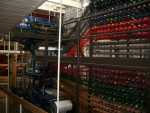
Fed by 3600 spools of wool!

The output of the carpet machine. The borders are not being created here so the central pattern can be sewn to something else to make a larger pattern.


This machine uses parts of a thistle-like plant to fluff up the surface of blankets.
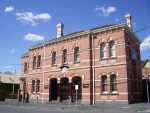
Ballarat has many lovely old buildings, a sign of the huge wealth once generated here.

I took a photo of this unassuming house because this is where my mother grew up.

Lake Wendoree is immediately behind us.

The boat house is for rowing shells.
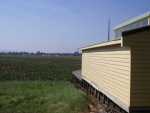
It is difficult to row a boat when there is no water in the lake.

When the 1956 Games were held in Melbourne, the rowing events were held in Ballarat.

Several months ago 5000 people WALKED along the course. There was great rejoicing with recent rains that brought Ballarat's water supply UP to 12% of capacity.
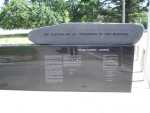
I don't know why this new memorial is in Ballarat but I'm glad that we have one someonewhere.
My cousin Nicole told me that former-PM Malcolm Fraser was invited to open the memorial but turned it down. Then just a day or so before, he changed his mind and demanded that he be allowed to do it. By then the Governor or someone else had been lined up to do it and that person's name carved in the stone you see here. Fortunately the organizers had the courage to tell him it was too late.
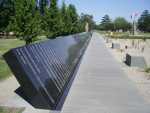
Too many POWs never made it home.
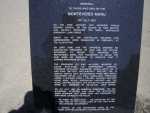

Sovereign Hill in Ballarat recreates the gold mining town that existed there in the 1850s.

At least, the children are led to believe there is gold in the creek. Whether they find any is another matter.

After the first wave of miners scavenged all the gold at or near the surface, most left town looking for new fields elsewhere. Then a group of men with tin-mining experience arrived from Cornwall and started following old river beds underground with spectacular success opening a second phase of mining. The Welcome Nugget found on the site weighed 69kg/2200 ounces!

Water was the greatest danger in the deep mines. The steam engine driving the pump is in the adjacent building.
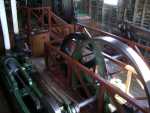
I seem to remember this huge contraption only produced 5hp or so.

Every 20 seconds or so, a bucket full of water arrived. Not much compared with small modern pumps.

An ox-drawn grinding wheel to crush quartz, hopefully containing gold.
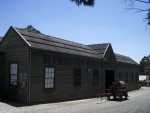
There was a demonstration using the "latest" (1880s) machinery, which drastically reduced the time and skill required to make a wheel though it would be a few more years before the wheel itself was redesigned with steel and rubber instead of wood with an iron rim.
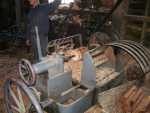
This lathe takes a short section of log and in seconds (with lots of noise) turns it into the shape of a wheel hub.
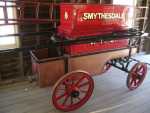
Teams of men on each side worked the pump - which must have been exhausting work. Presumably a bucket brigade kept the trough filled with water.
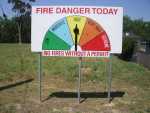
There are signs like this all over Australia. It is merely "high" in Creswick today.

Since I wasn't in a rush, I stopped to watch games in progress for a while. Generally the players are older but don't let that fool you into thinking it is easy. The balls are weighted to one side so they don't roll straight.

After looking over the fence for a while, I was invited in! Actually, the man who asked thought I was someone else but that didn't stop several people chatting with me about my trip.

Do regional town halls get any better than this? This is Bendigo, a major center in the 1850s gold rush.
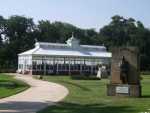
Since I was illegally parked, I didn't go over and investigate.

I mean the one on the right.

>The second-floor wrap-around balcony is an interesting feature. In the days before air-conditioning, the upper floors must have been unbearably hot in summer.
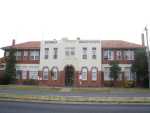
This backpacker hostel at Echuca on the Murray River is very different to the one in Melbourne. Instead of catering to the international traveler staying a few days, it is for fruit-pickers and other itinerant workers who might stay for weeks at a time. Given the drought, there has been little work for them though so I didn't meet any.

A "pub" is short for "public house" (or bar in American parlance).

I wanted a plain "pub" meal - sausages and mashed potatoes would have been good. They seem to have all gone upmarket. This one is offering "Thai curry chicken" and "Chicken and vegie fritatta". Whatever that is.
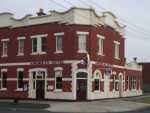
I ended up getting the "roast of the day" (lamb) at the American Hotel. After the gold ran out in California, quite a lot of Americans apparently came to Victoria.

Now a commercial building.

The (river) Port of Echuca. Agricultural products from much of inland Victoria and New South Wales were brought here to be loaded on to trains for Melbourne.

In 1884 when it was built, New South Wales and Victoria were separate British colonies so crossing the river was effectively moving between two countries.
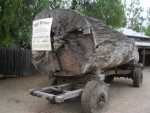
This looks old but it is only from 1958. It wasn't clear if actual logging carts were build like this. There didn't seem to be anyway of steering it. Maybe teams of oxen just dragged it around corners.
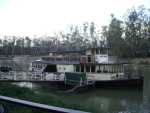
A paddle steamer tied up after a day carrying tourists. This one, the "Pride of the Murray" was built in 1924.

All that remains of a steel cable across the river that at one time allowed a ferry boat to pull itself across.
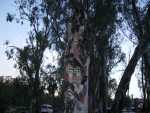
There was no explanation as to why people had nailed thongs to this tree but there they were.

In the morning I went into the supermarket thinking I'd get an orange juice and a cheese roll for breakfast. I got the juice but I couldn't resist the lamingtons - sponge cake coated with chocolate and dessicated coconut. This packet only lasted half an hour!
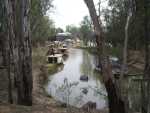
Riverboats parked in a billabong leading into the main river.

The wharf, or what is left of it. It was once 5 times as long. Note the difference between the current water level in the river and the top of the wharf; presumably it gets to the top when it floods.

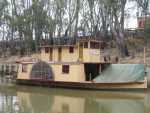
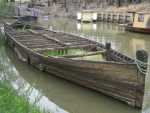
Apparently resting after years of service.

Stock have right of way? How ridiculous! Can't they be taught to look both ways before crossing?

Police had everyone else on the road pull over so that competitors could pass safely.

Aussies prefer meat pies for take-away meals. This one from Holbrook was excellent and I managed to avoid dripping the contents over me, a common problem.

A poor excuse for a tourist attraction. "Banjo" Patterson wrote a song about a dog that sat on the tucker (food) box, 5 miles from Gundagai. Here he is, or at least a replica of him.
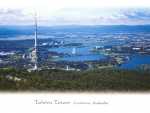

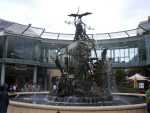
The amazing water clock and moving sculpture thing in Hornsby Plaza in Sydney's north.

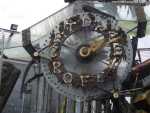



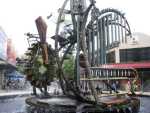

Also noting that the whole assembly rotates as the day passes.


Just in case you were interested.
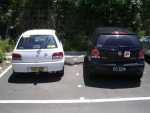
P plates! When you pass your driving test you have to place a red "P" on the car for the first year to warn other drivers that you are inexperienced and so may do something unexpected. You are also limited to 90 km/h (55mph), no blood alcohol and no more than one passenger. After that, you graduate to a green "P" for a year and a half. Your maximum speed is increased to 100 km/h (60mph). Of course, when learning, you get a big black on yellow "L" to warn everyone else that you are totally clueless and will likely do something really stupid without warning.

Beautiful!
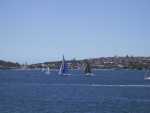
Sailboats Scandia and DHL, no doubt practicing for the Sydney-to-Hobart race that starts the day after Christmas.
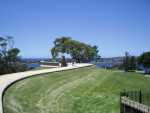
Georges Heights near Middle Head offers some spectacular views of Sydney Harbour. This is the 1st (left) of a series making a panorama.


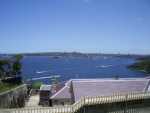
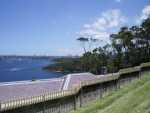

These were intended to destroy enemy shipping before they could attack Sydney. In addition to the guns placed up high, a string of mines was floated across the harbour from the headland below, later replaced by a net which a Japanese midget submarine circumvented in 1942.


Australia's first European outpost started at the foot of those skyscrapers. After sailing into Botany Bay just to the south and finding it lacking a good water source, the First Fleet sailed into what is now Sydney Harbour and set up camp here.

I didn't think so. It’s magnificent, isn't it?


BP used to have an oil terminal on Balls Head. The tanks have recently been removed and the area has been made into a park but this working part of the harbour is to be remembered.
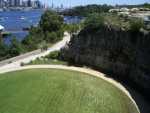
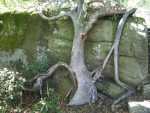
Just before we got here, my sister showed me an aboriginal painting under a rock ledge. She works as a conservation planner for the local council and mentioned that the aboriginies don't like white fellas to know where there paintings and other sacred places are - which makes it difficult to know what to protect from developers.

Balls Head Reserve
Persons removing soil, destroying trees or shrubs 'native or otherwise' or damaging any portion of reserve will be rigorously prosecuted.
Persons observing vandalism of any description are kindly requested to report same to ranger or council chambers: X507
This is your recreational ground.
Please do what you can to preserve it.
By order R.E. Petty, Town Clerk."

I used to sail a boat like this when I was a child as you can see here. It is only 2.5m/8ft long.
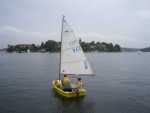
Dad is in the boat while they gain confidence to do it themselves.
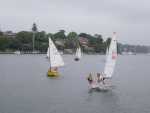
This was my last full day in Sydney. :-(